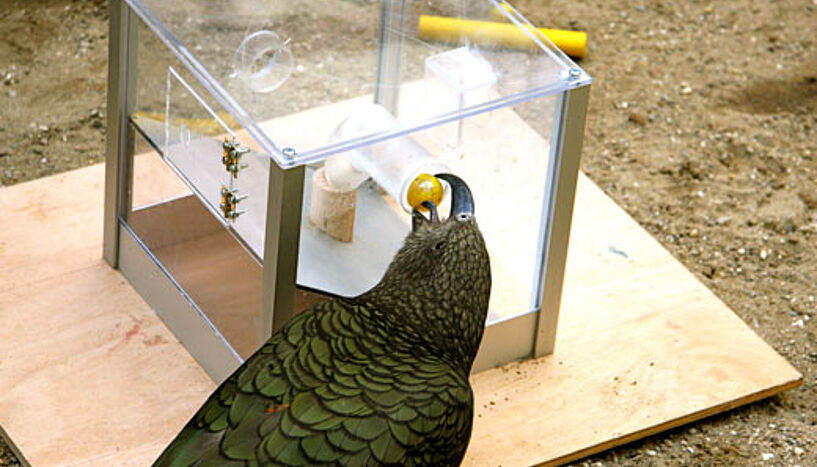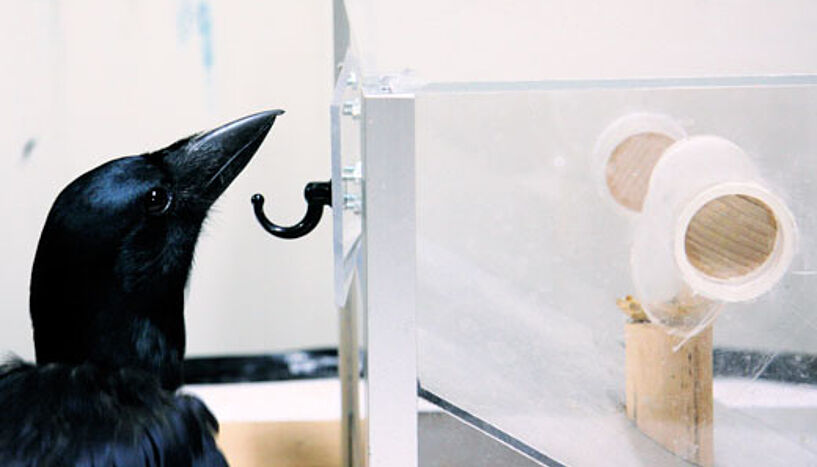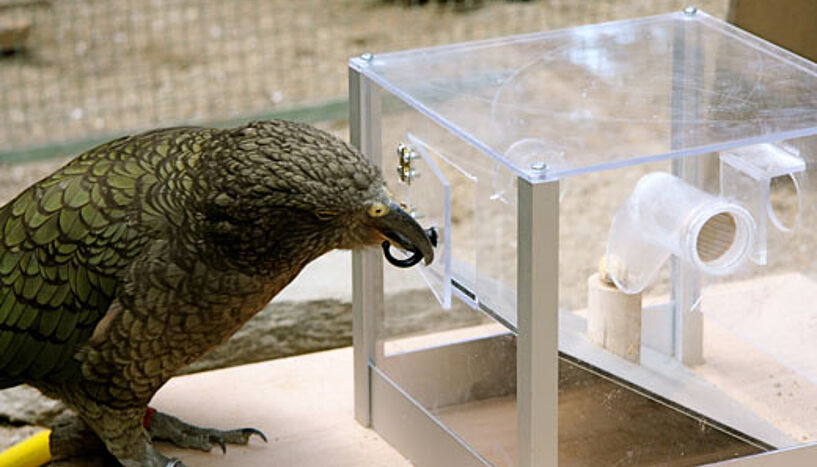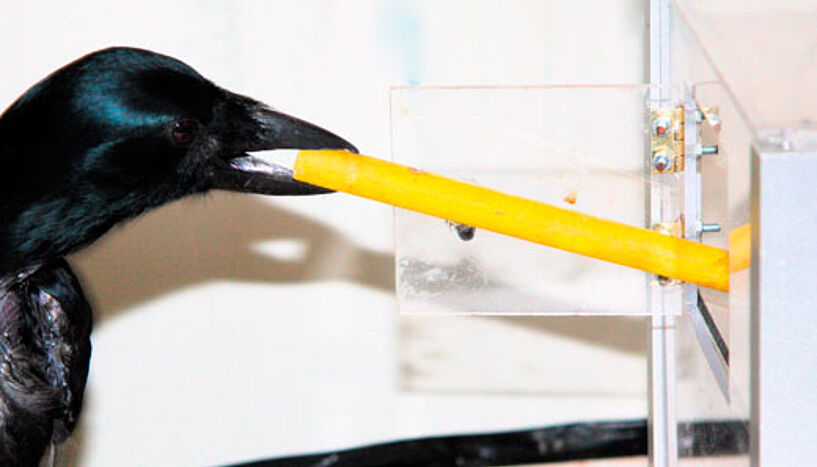Clever Tool Use in Parrots and Crows
10. Juni 2011The kea, a New Zealand parrot, and the New Caledonian crow are members of the two most intelligent avian families. Researchers from the Department of Cognitive Biology in Vienna investigated their problem solving abilities as well as their innovative capacities. They are publishing two new studies – one in cooperation with members of the Behavioral Ecology Research Group in Oxford – in the scientific journals PLoS ONE and Biology Letters.
Parrots and Corvids frequently astonish researchers investigating animal intelligence, in particular when it comes to solving technical problems. The New Caledonian crow (Corvus monduloides), for example, manufactures and uses elongated objects such as sticks or pieces of Pandanus leaves as tools to probe for grubs in tree bark and dead wood. The kea (Nestor notabilis), a mountain parrot which is unknown to employ tools in the wild, can accomplish the use of compact objects tools to knock a food reward out of place.
Inspector and tool maker
The kea is a parrot endemic to the mountain region of the South Island of New Zealand such as Mount Cook National Park, Arthur's Pass. It is about 45 centimeters in body length, olive green with red underwings, highly curious and famous for its urge to examine and disassemble novel objects. With about 40 centimeters body length, the black New Caledonian crow, a corvid (crows, magpies, jays and ravens), is a medium sized representative of its family. Ludwig Huber, the leader of the Department of Cognitive Biology, explains: "It shows great innovative skills when it comes to technical problems involving tool use.”
Food reward in plexiglas box
The goal of the study, which was published in the scientific journal PLos ONE, was to compare the efficiency and the flexibility of the two species. The researchers from the University of Vienna cooperated with their colleagues from the Department for Zoology of the University of Oxford. They confronted six kea and five New Caledonian crows with a Multi Access Box in a transparent plexiglas cube. Each side wall represented another possible solution to achieve the same food reward which was presented on a platform in the center of the box. Alice Auersperg, who is corresponding author to this publication and who conducted the study, explains: "The animals could choose between pulling a string which was tied around the reward, pulling a hook-shaped lever to open a window, inserting a marble (compact tool) into a curved ball-path leading towards the reward or inserting a rod-shaped stick-tool into an opening and maneuver it over a gap towards the food in order to push the reward off its platform."
Gyula Gajdon, who is a co-author from the Department of Cognitive Biology in Vienna, adds: "The animals could choose which solution they wanted to employ first. Once they had established a solution and had used it a certain number of times we blocked the entrance, forcing them to switch to another. This way we could observe not only the differences in the order of solutions that the animals established but also how quickly they were able to switch."
Species champions "Kermit" und "Uek"
Just one animal of each species accomplished all four solutions. The most difficult solution for the kea was the use of a stick-like object as a tool. This is not surprising since the kea is not a natural tool user in the wild. Additionally, maneuvering an elongated tool inside a curved beak is a highly complex motor task. "It is therefore all the more impressive that Kermit succeeded to overcome this handicap. The strategy he used gives the strong impression that he acted in a goal directed matter," states Ludwig Huber.
The greatest challenge for the crow was to open a window by pulling a hook-shaped lever. We know that New Caledonian crows use their tools to haptically explore scary looking objects from a safe distance; they did not use pulling and tearing actions (which require a longer period of body contact than simple pecking actions with the beak or the tool) towards such objects, even if a food reward is involved." After Uek succeeded to open the window, she would not stick her head through the entrance to directly reach for the food like the kea did but instead used the stick to poke it off its platform," explains Alice Auersperg.
Aiming a tool into a desired direction
In a follow-up study of the same researchers from the University of Vienna which was published in Biology Letters, three further kea learned to insert a stick tool through a hole inside a vertical wall and to poke an out-of-reach food reward behind that wall off its platform after watching some demonstration trials by Kermit. Furthermore they were able to aim the functional tool end at the positive option of two (a baited versus an unbaited box). This is remarkable since kea, which do not use stick-like material during nest construction but breed in simple burrows instead, do not seem to have an ecological predisposition to handle elongated objects.
A new approach to cognitive science
The researchers hope to gain more insight into the evolution of intelligence from their results. Instead of just investigating which problems an animal is capable of mastering, the focus of cognitive science should additionally be on the mechanisms underlying these accomplishments. The Department of Cognitive Biology at the University of Vienna, an important segment of the global scientific community, consists of the research teams of three professors Ludwig Huber, Tecumse Fitch and Thomas Bugnyar. They investigate the intelligence and communication of various birds and mammals. In November 2010, a new research station Haidlhof in Lower Austria was inaugurated – a cooperation of the University of Vienna with the Veterinary University of Vienna.![]() Video
Video
(Copyright: University of Vienna, Department of Cognitive Biology)
Publications
Flexibility in problem solving and tool use of kea and New Caledonian crows in a Multi Access Box paradigm (Alice Auersperg, Auguste von Bayern, Gyula K. Gajdon, Ludwig Huber, Alex Kacelnik). In: PLoS ONE, June 8, 2011
DOI: 10.1371/journal.pone.0020231![]() Abstract
Abstract
Navigating a tool end in a specific direction: stick tool use in kea (Nestor notabilis) (Alice Auersperg, Ludwig Huber und Gyula K. Gajdon). In: Biology Letters, June 1, 2011
DOI: 10.1098/rsbl.2011.0388![]() Abstract
Abstract
Further Information![]() Kea Lab of the Department of Cognitive Biology
Kea Lab of the Department of Cognitive Biology![]() Behavioural Ecology Research Group University of Oxford
Behavioural Ecology Research Group University of Oxford
Scientific Contact
Ao. Univ.-Prof. Mag. Dr. Ludwig Huber
Head of the Department of Cognitive Biology
University of Vienna
1090 Vienna, Althanstraße 14 (UZA I)
T +43-1-4277-761 10![]() ludwig.huber(at)univie.ac.at
ludwig.huber(at)univie.ac.at
Queries
Mag. Alexander Dworzak
Public Relations
University of Vienna
1010 Vienna, Dr.-Karl-Lueger-Ring 1
T +43-1-4277-175 31
M +43-664-602 77-175 31![]() alexander.dworzak(at)univie.ac.at
alexander.dworzak(at)univie.ac.at
Wissenschaftlicher Kontakt
Ao. Univ.-Prof. Mag. Dr. Ludwig Huber
Leiter des Departments für KognitionsbiologieUniversität Wien
1090 - Wien, Althanstraße 14 (UZA I)
+43-1-4277-761 10
ludwig.huber@univie.ac.at
Rückfragehinweis
Mag. Alexander Dworzak
ÖffentlichkeitsarbeitUniversität Wien
1010 - Wien, Universitätsring 1
+43-1-4277-175 31
+43-664-602 77-175 31
alexander.dworzak@univie.ac.at
Downloads:
Kea_Ball_01.jpg
Dateigröße: 6,72 MB
Crow_Window_01.jpg
Dateigröße: 4,21 MB
Kea_Window_01.jpg
Dateigröße: 5,74 MB
Crow_Stick_Uek_01.jpg
Dateigröße: 2,67 MB
Kea_Portrait_Linus.jpg
Dateigröße: 4,35 MB





